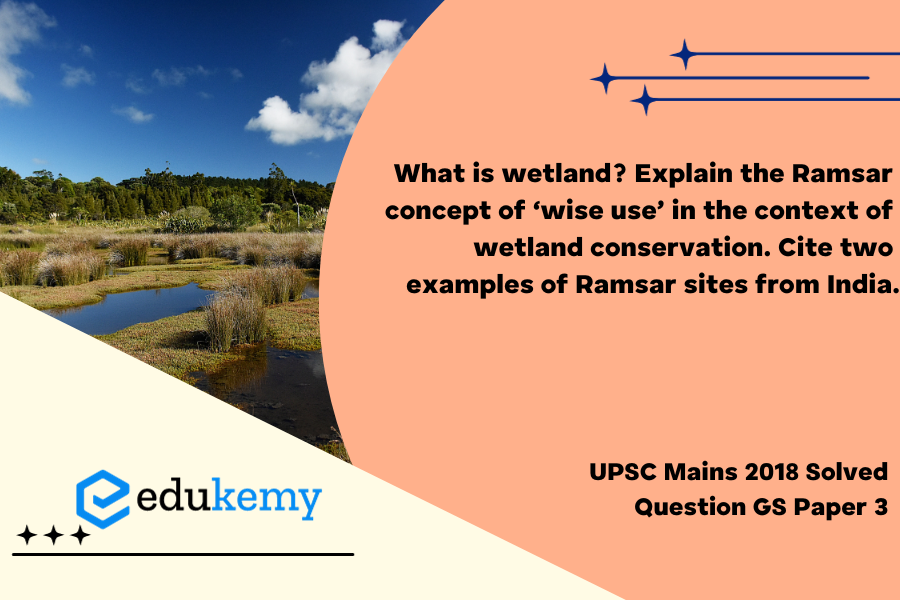Wetlands are vital ecosystems characterized by the presence of water, influencing the soil, flora, and fauna within them. These areas, which can be transitional or permanent, encompass a variety of habitats such as marshes, swamps, bogs, and mangroves. They play pivotal roles in regulating water flow, filtering pollutants, and providing habitats for countless species.
The Ramsar Convention, established in 1971, aims to conserve and sustainably use wetlands. Central to this initiative is the concept of ‘wise use,’ emphasizing the need to maintain the ecological character of wetlands while allowing for their sustainable utilization. This approach ensures that human activities do not degrade the essential functions of these ecosystems.
India, a signatory to the Ramsar Convention, has designated several Ramsar sites. Two prominent examples include the Chilika Lake in Odisha, the largest coastal lagoon in India, and the Keoladeo National Park in Rajasthan, renowned for its avian diversity. These sites highlight India’s commitment to conserving its invaluable wetland ecosystems through the principles of ‘wise use.’
Tags: Conservation, environmental pollution and degradation, environmental impact assessment.
Contents
Decoding the Question:
- In the introduction, define wetlands.
- In Body,
- Write in brief about wetland conservation and the Ramsar Convention.
- After this, explain the concept of ‘wise use’.
- Give two examples of Ramsar sites from India and discuss them in brief.
Answer:
Wetlands are ecotones between terrestrial and aquatic ecosystems. They periodically get inundated with water. They support a flourishing community of aquatic organisms including frogs and other amphibians. Swamps, marshes and mangroves are examples of wetlands.
Ramsar Convention (Convention on Wetlands) Concept of ‘Wise Use’: According to Ramsar Convention on Wetlands, ‘Wise use’ of wetlands is the maintenance of their ecological character, achieved through the implementation of ecosystem approaches, within the spirit of sustainable development. ‘Wise Use’ guidelines encourage Contracting Parties to:

- adopt national wetland policies with legislations and institutional arrangements to deal with wetland;
- develop programs of wetland inventory, monitoring, research, training, education and public awareness; and
- take actions involving the development of integrated management plans covering every aspect of the wetlands and their relationships with their catchments.
The practical applications of “Wise Use” concept are as follows:
- Use of Water: Farmers in wetland regions require freshwater for cultivation of paddy, fruits and vegetables. But, it should not lead to overexploitation of freshwater else wetland’s regenerative capacity will suffer. Fish, reptiles and amphibians will die. Therefore, the Government may impose legal ‘upper limits / ceiling’ on water use.
- Use of Land: Wetlands purify air and water, they moderate adverse weather impacts and thus protect human health. However, mining, infrastructure and transportation services harm wetlands, and thereby indirectly harm human health. Hence, the ‘land’ of wetland should be generally not used for such activities.
- Use of Biomass: Fishing is one of the primary occupations of people in Wetland areas. But excessive fishing, especially during the reproduction season will harm wetland’s food web. Hence, the government may impose restrictions and encourage aquaculture and ‘rice-fish’ management practices.
Ramsar sites from India: Currently India has75 wetlands under Ramsar convention and its significance and importance can be conserved only by its wise use. The important Ramsar sites are: Chilika lake (Odisha), Keoladeo National Park (Rajasthan), Loktak Lake (Manipur), Ashtamudi Wetland (Kerala) etc.
Conclusion
Wetlands are very significant from ecological, economic, social, and disaster management point of view. They play a very significant role in countries’ ecosystem health, disaster proofing of urban areas especially urban areas when they face flash flood, storm surges, etc. Therefore, wetlands need to be conserved by managing and applying a sustainable development approach and its strict wise use.
In case you still have your doubts, contact us on 9811333901.
For UPSC Prelims Resources, Click here
For Daily Updates and Study Material:
Join our Telegram Channel – Edukemy for IAS
- 1. Learn through Videos – here
- 2. Be Exam Ready by Practicing Daily MCQs – here
- 3. Daily Newsletter – Get all your Current Affairs Covered – here
- 4. Mains Answer Writing Practice – here


